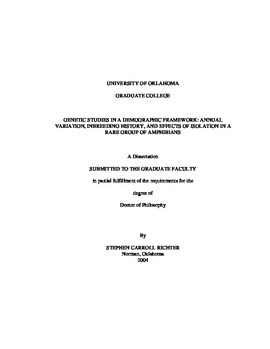| dc.contributor.advisor | Caldwell, Janalee P., | en_US |
| dc.contributor.advisor | Broughton, Richard E., | en_US |
| dc.contributor.author | Richter, Stephen Carroll. | en_US |
| dc.date.accessioned | 2013-08-16T12:19:31Z | |
| dc.date.available | 2013-08-16T12:19:31Z | |
| dc.date.issued | 2004 | en_US |
| dc.identifier.uri | https://hdl.handle.net/11244/783 | |
| dc.description.abstract | Rana sevosa had significantly lower genetic variation than non-isolated populations of its sister taxa. In fact, the isolated population had an observed heterozygosity that was 72% and allelic richness that was 61% of the average non-isolated population. Seven alleles were lost from the population during 1995--2004. No differences were found for heterozygosities over this period, but significant population structuring among years evidenced by FST and RST, corroborated previous demographic data of high annual population turnover and small population size. Additionally, it appears that a historic bottleneck (pre 1997) and a more recent bottleneck (between 1997 and 2001) occurred based on genetic signatures. Finally, mechanisms of enhanced fitness were explored (1) differential survival of more genetically diverse offspring, (2) mass mortality of egg clutches based on high relatedness of parents, and (3) pairing of more genetically different mates. A positive relationship was found between genetic variability and fitness for individuals surviving to metamorphosis and for survival of embryos within egg clutches, which suggests that more outbred individuals had higher fitness. No evidence was found for non-random mating with respect to genotype. | en_US |
| dc.description.abstract | Anthropogenic habitat fragmentation and reduction are major causes of population declines and extinction. As these processes intensify, our ability to rescue imperiled taxa is critically dependent on an understanding of historical, demographic, and genetic parameters of shrinking populations. Opportunities to study all three and their interactions in natural populations are rare. Such opportunity existed in an isolated population of the US endangered Dusky Gopher Frog, Rana sevosa. With rapid contraction of its historic range, one might predict a substantial reduction in genetic variation. However, the actual effects of rapid decline on population size, genetic diversity, and population processes were unknown. Microsatellite DNA markers were used to address four research objectives: (1) to compare genetic variation in the isolated population of R. sevosa to non-isolated populations of its two sister taxa; (2) to address inbreeding history of the isolated population; (3) to determine temporal change versus stasis (over a ten-year period) in population polymorphism of R. sevosa; and (4) to address preservation of genetic variability via fitness-related consequences of inbreeding. | en_US |
| dc.format.extent | xiii, 118 leaves : | en_US |
| dc.subject | Frog populations. | en_US |
| dc.subject | Amphibian declines. | en_US |
| dc.subject | Biology, Zoology. | en_US |
| dc.subject | Biology, Ecology. | en_US |
| dc.subject | Biology, Genetics. | en_US |
| dc.subject | Fragmented landscapes. | en_US |
| dc.subject | Frogs. | en_US |
| dc.title | Genetic studies in a demographic framework: Annual variation, inbreeding history, and effects of isolation in a rare group of amphibians. | en_US |
| dc.type | Thesis | en_US |
| dc.thesis.degree | Ph.D. | en_US |
| dc.thesis.degreeDiscipline | Department of Biology | en_US |
| dc.note | Advisers: Richard E. Broughton; Janalee P. Caldwell. | en_US |
| dc.note | Source: Dissertation Abstracts International, Volume: 65-08, Section: B, page: 3844. | en_US |
| ou.identifier | (UMI)AAI3143543 | en_US |
| ou.group | College of Arts and Sciences::Department of Biology | |
